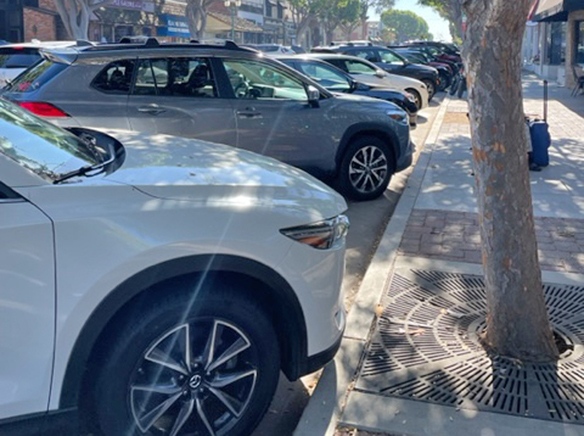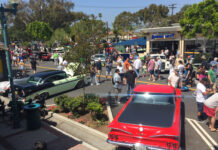By Sara Bass
Seal Beach lags behind nearly all other Southern California beach towns when it comes to paid on-street parking in its downtown district.
A forecasted five-year deficit, persistent congestion, and the increasing difficulty of finding parking on Main Street prompted the City Council to appoint a parking advisory ad-hoc committee in July. The public official and citizen comprised committee is tasked with analyzing data and community interests to inform a suggestion on better parking management.
The present dialogue over paid parking on Main Street is preceded by other ardent discussions that saw a stubborn grip on free parking persevere in maintaining the city’s reputation as the region’s parking outlier.
“People feel like it’s the last beach town, and they want to keep it that way. And every time something comes across that people feel is a threat to that, they get very emotional,” 2002 Councilman Paul Yost told the LA Times in the midst of one of these previous discussions.
This concern of commercialization that supplants small town charm endures as one of the most personal stakes people have on the topic of parking. Data is relevant to several concerns, including loss of business, intolerable spillover onto residential streets, and even this most personal one.
Across various studies of paid parking’s impact on cities, researchers can track a “virtuous cycle,” a phrase coined by Urban Planning professor and parking pioneer Donald Shoup, of meter revenue paying for public improvements that in turn attract more visitors. These studies also reflect that along with proper on-street parking management comes increased sales tax revenue and a wide margin of opportunity to invest in other services important to the city.
The proposal
The present proposal for Main Street’s parking management is based on research compiled by Seal Beach parking consultant Julie Dixon and her team at Dixon Resources Unlimited. It includes charging for 221 total spaces that line Main Street and extend shallowly onto Electric, Central, and Ocean Avenues.
Ideally, one pay station would stand at both ends of the street per block face, wrote Seal Beach Police Capt. Nick Nicholas in an email, and they would rely on License Plate Reader technology to track payment. They would also accept cash.
Equipment and ongoing operating costs are estimated at just over $180,000. Dixon’s team expects a net gain at the end of the first year running the program with rates starting at $1 per hour, the lowest hourly rate of any nearby downtown.
Also on the table is the monetization of the Eighth Street municipal parking lot. This lot is similarly anticipated to end the first year with a net gain.
Parking needs to be efficient and predictable, said Dixon. One primary goal is to facilitate a uniform parking experience across the downtown district, so those planning to drive are least perturbed by policy and can expect a stall.
Has this worked elsewhere?
The right price for curb parking encourages short-term parking that facilitates more turnover, decreases time spent cruising to find an available stall, and attracts more customers who spend more money at local businesses, writes Shoup. He adds that the primary goal of charging market prices for curb parking is not to maximize profit.
Old Town Pasadena is the perennial example of successful parking management. Five years after installing meters throughout its downtown, the city’s sales tax revenue quadrupled and quickly surpassed that generated in the nearby shopping mall with free parking.
The city also elected to allocate a portion of meter revenue to public services like sidewalk and street maintenance and marketing tactics to attract more visitors to town.
With input from its community parking districts—governing bodies that collaborate on investment strategies for parking meter revenue—San Diego, as of 2011, spent just under half its parking revenue across three districts to improve alternative transportation, signage, landscaping, and security, in addition to parking directly. The rest went toward the general fund.
Today, parking meters are expanding through San Diego’s Pacific Beach to facilitate turnover and expand access to its businesses. Future revenue is considered for bike parking and pedestrian improvements. In July, Pacific Beach parking district helped launch an all-electric shuttle to increase mobility throughout the district and reduce a reliance on cars.
The city is also discussing two additional community parking districts in San Ysidro and Kearny Mesa that could create more revenue to subsidize sidewalk repair, street lighting, or neighborhood shuttles.
Ventura’s investment of parking meter revenue in lighting and street beautification contributed to a 40% drop in crime after six months of launching its paid on-street parking program. And within the first 30 minutes, then Mayor Fulton noticed all-day parkers – including employees – had moved into the parking garage and lots, expanding access for shoppers.
When it comes to Seal Beach, there is the same opportunity to reduce congestion and invest in street beautification that actually declutters the streets and substantiates Seal’s charm, draws more customers, and creates new opportunity to fund other valued public services. There’s also the high likelihood that paid parking would prompt beach-goers and employees away from the prime real estate on Main Street, allowing instead for shoppers’ better access.
The question of equity
Shoup points out that the costs of free parking just posture as things other than a dollar bill and end up befalling everyone. If visitors come across a prime parking stall for free on their first go around the block, they could just be lucky. But, the majority of the time, we all incur the additional burdens of lost time spent circling the block for a convenient stall or trying to wade through the ensuant congestion, dangerous conditions to ourselves and other pedestrians, and the inane tons of carbon dioxide emitted from idling.
For those who live in town, tax dollars often contribute to the city’s maintenance of on-street parking stalls when individual drivers don’t pay their vehicles’ short-term rent. These costs fall on all residents, even those who primarily walk and bike, including those in Seal Beach.
What could this look like in Seal?
Seal Beach’s parking consultant Julie Dixon continually stresses the flexibility of a parking program that meets the unique needs of Seal’s community, even with demand fluctuations across season and street block.
One amendment to the program she reiterates—namely in reference to those making a coffee run and food delivery drivers—is a 20-minute-free button option per license plate per day. This option would be available on a mobile app called Passport, currently used at the beach lots. Instructions on interacting with the pay stations, including use of Passport, could be offered in a walk-through after council settles on a decision.
Dixon also raised the option of forming a community parking district to determine where and how much generated revenue to allocate beyond the general fund and bolstering of parking enforcement, as did various other cities. This decision would be determined by council. Though, without a figure on total revenue, it is premature to tell how bulky any of those investments might be, wrote Nicholas.
Future appendages to the program could also be things like an employee permit program, accounting for spillover with modifications to parking management on residential streets lacking time limits, and modifying municipal parking lot regulations to better accommodate salon customers parked for more than two hours.
Nicholas is also hopeful the expected increase in turnover that comes with right-priced on-street paid parking would improve pedestrian safety conditions by reducing incentives to make quick U-turns in an attempt to snag the uncommon empty Main Street parking stall.
No one’s saying paid parking solves everything
There will always remain a perception of insufficient parking even with best management practices, said Dixon, because there will not necessarily always be convenient parking nearby everyone’s destination.
There might remain high concentrations of cars parked downtown, especially during peak demand times; but improved parking management like the kind Dixon is proposing could facilitate a more efficient and predictable parking experience for Seal’s residents and patrons. At the same time, the city’s health, safety, and appeal would almost certainly benefit.
There could also be the hurdle of allowable spending stipulated by California state law of parking meter revenue, something San Diego grappled with in 2017.
Due to the condition of parking reform being inconclusive, as seen in conversations in the city’s past and almost guaranteed to recur in its future, Dixon emphasizes the importance of malleability as essential to a parking program’s success.
Just as critical, she says, is to drive reforms with data rather than perception in order to continually strive to address a vast array of community interests.
Next steps
The Citizen-Council Ad Hoc Parking Advisory Committee will pose its suggestion to City Council next month. Council will then submit a proposal to California Coastal Commission. Based on Coastal Commission’s response, council will then settle on a decision for modifying its parking program.
Currently, council is awaiting a response from Coastal Commission on its proposal to increase beach lot rates.
Depending on when it hears back, the timeline for approving any broader parking proposal will be more predictable. The city also received a grant to incorporate a micro-shuttle connecting to both Long Beach and Huntington Beach. If implemented, it would expand accessibility to downtown and subsidize alternative modes of transportation. Preserving a small town feel has been an enduring priority and point of pride for Seal Beach residents for decades. It has been a primary reason for denying paid on-street parking each time the topic comes up. This year, there’s opportunity to reconsider how the city might make the decision to support this priority using neighborhood-specific data and evidence from surrounding communities.
The parking advisory ad-hoc committee meets next at the Council Chambers on Wednesday, Nov. 29 at 5:30 p.m.












